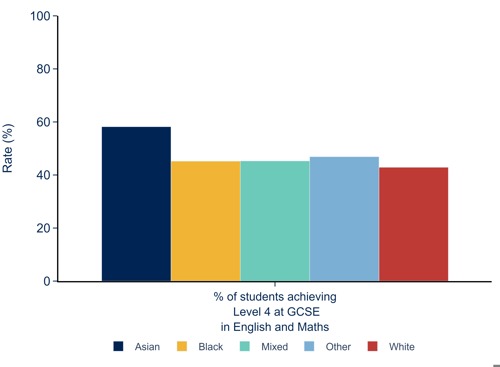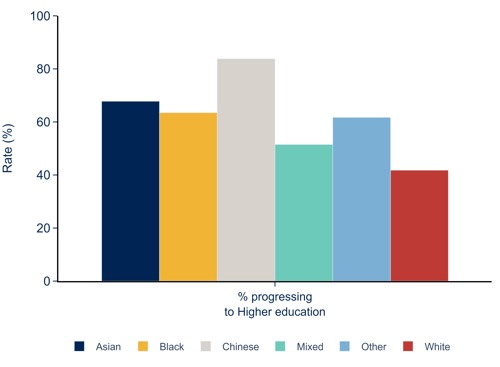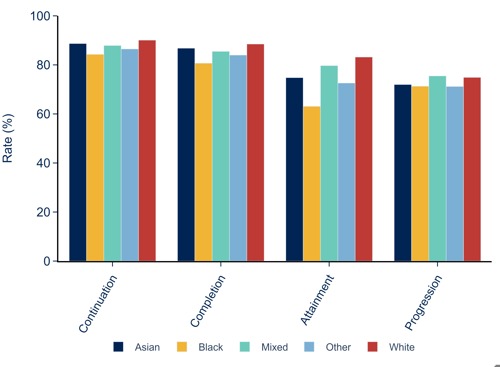Ethnicity
This refers to the ethnic group that a person identifies themselves as belonging to.
Studies use a range of different classifications. The UK government finds that across its datasets, 43 different ethnic groups are referred to. However, the most commonly used datasets categorise people into between five and 20 ethnic groups.
The OfS uses groupings of two, five and 15. Some studies refer to black and minority ethnic students (BAME) or non-white students. The OfS does not use this language, but we have included studies that use these definitions under the ‘further reading’ section of this page.
Key statistics
Key Stage 4 GCSE attainment:
Department for Education, ‘Key stage 4 performance, Academic year 2022/23’ October 2023.
Access to higher education:
Department for Education, ‘Widening Participation in Higher Education’ publication July 2023.
Continuation – Progression:
Available data as of January 2024 from: The Education and Skills Funding Agency’s (ESFA’s) individualised learner record (ILR), The Student Return, collected by the Designated Data Body (DDB) and The Student Alternative (SA) record, collected by the Designated Data Body (DDB).
Available data as of January 2024 from: The Education and Skills Funding Agency’s (ESFA’s) individualised learner record (ILR), The Student Return, collected by the Designated Data Body (DDB) and The Student Alternative (SA) record, collected by the Designated Data Body (DDB).
On a provider level:
UCAS provide information on ethnicity after the application process has been completed. This can then be matched to Individual Learner records by a provider for internal database purposes.
The access and Participation data dashboard has information on the access, continuation, completion, attainment and progression rates of students by ethnic group (5-way).
The student outcomes data dashboard has information on the continuation, completion and progression rates of students by ethnic group (5-way).
The sector distribution of student outcomes and experience measures data dashboard has information on the continuation, completion and progression rates of students by ethnic group (5-way).
The size and shape of provision data dashboard has information on the profile of entrants by ethnic group (5-way).
The TEF data dashboard has information on the continuation, completion and progression rates of students by ethnic group (5-way).
On a national level:
The student characteristics data: Outcomes data dashboard has information on the profile, continuation, completion, attainment and progression rates of students by ethnicity (2-way, 5-way and 15-way).
National Student Survey data: student characteristics data has information on the experience of students by FSM eligibility.
The Department for Education ‘Education Statistics service’ also has information on ethnicity of students by school.
Note: Definitions and the quality of each study vary.
Advance HE (2020) ‘Equality in higher education: Statistical reports 2020’. (Accessed 12/12/2023)
Advance HE (2021) ‘Understanding Structural Racism in UK Higher Education: an introduction’. (Accessed 12/12/2023)
Arday, J, and Mirza, H (Eds) (2018). ‘Dismantling Race in Higher Education – Racism, Whiteness and Decolonising the Academy’, Palgrave Macmillan;
Arday, J, Zoe Belluigi, D, and Thomas, D (2021). ‘Attempting to break the chain: Reimaging inclusive pedagogy and decolonising the curriculum within the academy’. Educational Philosophy and Theory, 53(3), 298–313. doi.org/10.1080/00131857.2020.177325;
'Average score for students taking A levels and other qualifications'.(Accessed 12/01/2024)
Baars, S., E. Mulcahy, and E. Bernardes. 2016. ‘The Underrepresentation of White Working Class Boys in Higher Education the Role of Widening Participation.’
Ball, S.J., D. Reay, and M. David (2002) ‘‘Ethnic Choosing’: Minority Ethnic Students, Social Class and Higher Education Choice.’ Race Ethnicity and Education 5 (4): 333–357. doi:10.1080/1361332022000030879. [Taylor & Francis Online], [Google Scholar];
Bland, B (2015) ‘Focus on access and retention. Risks for students who are estranged or disowned by their family’. Access_and_Retention.Final.pdf (thestandalonepledge.org.uk)
Boliver V. (2016) ‘Exploring Ethnic Inequalities in Admission to Russell Group Universities’. Sociology. 2016 Apr;50(2):247-266. doi: 10.1177/0038038515575859. Epub 2015 May 12. PMID: 27904229; PMCID: PMC5117128.
Boliver, V. (2013), ‘How fair is access to more prestigious UK universities?’. The British Journal of Sociology, 64: 344–364, which has been published in final form at http://dx.doi.org/10.1111/1468-4446.12021
Bowes, L., J. Evans, T. Nathwani, G. Birkin, A. Boyd, C Holmes, and S Jones. (2015) ‘Understanding Progression into Higher Education for Disadvantaged and under-represented Groups.’
Britton, J., Dearden, L. & Waltmann, B. (2021) ‘The returns to undergraduate degrees by socio-economic group and ethnicity’. Institute for Fiscal Studies
C McCabe, K Keast & M. S Kaya (2022) ‘Barriers and facilitators to university access in disadvantaged UK adolescents by ethnicity: a qualitative study’, Journal of Further and Higher Education, 46:10, 1434-1446, DOI: 10.1080/0309877X.2022.2086037
Chang, M. J., Eagan, M. K., Lin, M. H., & Hurtado, S. (2011). ’Considering the impact of racial stigmas and science identity: Persistence among biomedical and behavioral science aspirants’. The Journal of Higher Education, 82(5), 564–596. [Taylor & Francis Online] [PubMed] [Web of Science ®], [Google Scholar];
Crawford & Greaves, E. (2015) ‘Socio-economic, ethnic and gender differences in HE participation’. Department for Business Innovation & Skills
'Entry rates into higher education'. (Accessed 10/12/23)
Equality and Human Rights Commission (2019) ‘Tackling racial harassment: Universities challenged’. (Accessed 11/01/2024)
Henderson, M., Sullivan, A., Anders, J. & Moulton, V. (2018) ‘Social Class, Gender and Ethnic Differences in Subjects Taken at Age 14’. The Curriculum Journal. 29 (3), 298–318.
Henehan, K. & Rose, H. (2018) ‘Opportunities Knocked? Exploring pay penalties among the UK’s ethnic minorities’. Resolution Foundation
Hillman, N., and N. Robinson (2016.) ‘Boys to Men: The Underachievement of Young Men in Higher education-and How to Start Tackling It’. Higher Education Policy Institute Oxford.
Johnson, A and Joseph-Salisbury, R (2018). ‘Are You Supposed to Be in Here?’ Racial Microaggressions and Knowledge Production in Higher Education. In Arday, J and Mirza, H S (Eds), Dismantling Race in Higher Education: Racism, Whiteness and Decolonising the Academy (pp. 143–160). Springer International Publishing. doi.org/10.1007/978-3-319-60261-5_8
Lessard-Phillips, L., Boliver, V., Pampaka, M., & Swain, D. (2018). ‘Exploring ethnic differences in the post-university destinations of Russell Group graduates’. Ethnicities, 18(4), 496-517. https://doi.org/10.1177/1468796818777543
Liyanage, M (2020). ‘Miseducation: Decolonising curricula, culture and pedagogy in UK universities’ (Debate Paper 23). HEPI. www.hepi.ac.uk/2020/07/23/miseducation-decolonising-curricula-culture-and-pedagogy-in-ukuniversities; UUK and NUS (2019). Black, Asian and Minority Ethnic student attainment at UK universities: #closingthegap. www.universitiesuk.ac.uk/policy-and-analysis/reports/Pages/bame-student-attainment-ukuniversities-closing-the-gap.aspx
Liz Thomas and Robert Jones (2017), ‘Student engagement in the context of commuter students’, The Student Engagement Partnership, p.34
Mark Holton & Kirsty Finn (2018) ‘Being-in-motion: the everyday (gendered and classed) embodied mobilities for UK university students who commute’, Mobilities, 13:3, 426-440, DOI: 10.1080/17450101.2017.1331018; HEPI-Homeward-Bound-Defining-understanding-and-aiding-‘commuter-students’-Report-11429_11_18Web-1.pdf;
Noden, P., M. Shiner, and T. Modood. 2014. ‘Black and Minority Ethnic Access to Higher Education’. London: LSE. (Accessed 7 June 2022)
Office for Students (2023) Insight brief 19. ‘Protecting students as consumers’.
Office for Students (2023) ‘Student outcomes data dashboard’. (Accessed 12/01/2024)
Pokorny, H., Holley, D. & Kane, S. (2017) ‘Commuting, transitions and belonging: the experiences of students living at home in their first year at university’. High Educ 74, 543–558 (2017). https://doi.org/10.1007/s10734-016-0063-3
Sammons, P. M., K. Toth, and K. Sylva. 2015. ‘Background to Success: Differences in A-level Entries by Ethnicity, Neighbourhood and Gender’. London: The Sutton Trust. (Accessed 12/01/2024)
Shiner, M., and T. Modood. 2002. “Help or Hindrance? Higher Education and the Route to Ethnic Equality.” British Journal of Sociology of Education 23 (2): 209–232. doi:10.1080/01425690220137729.
Social Mobility Commission ‘State of the Nation 2023: People and places’. (Accessed 12/01/2024) (publishing.service.gov.uk)
Stevenson, J., O'Mahony, J., Khan, O., Ghaffar, F., & Stiell, B (2019) ‘Understanding and overcoming the challenges of targeting students from under-represented and disadvantaged ethnic backgrounds’. (Accessed 12/01/2024)
TASO (2023) ‘Rapid review to support development of the Equality of Opportunity Risk Register’. (Accessed 12/01/2024)
'Turning the corner on value for money – 2018 HEPI / Advance HE Student Academic Experience Survey highlights students’ belief that value for money in higher education is improving'. (Accessed 12/12/2023)
Universities UK (2019) ‘Black, Asian and Minority Ethnic student attainment at UK Universities: #Closingthegap’ Universities UK. (Accessed 11/01/2023)
Universities UK (2023) ‘Tackling racial harassment in higher education: progress since 2020’. Universities UK. (Accessed 12/01/2024)
Describe your experience of using this website



